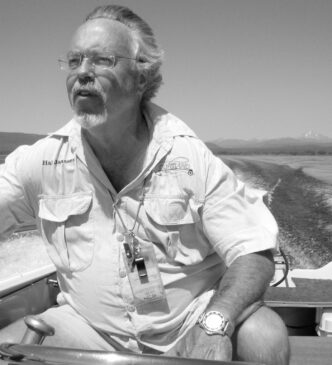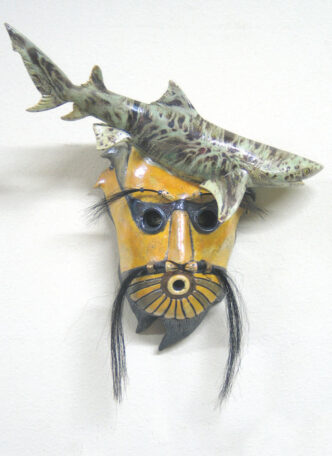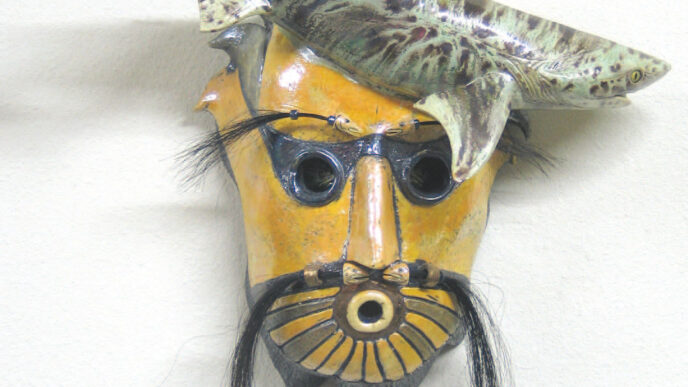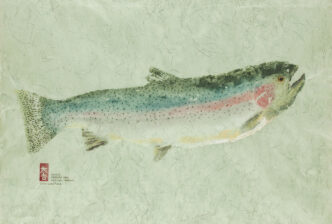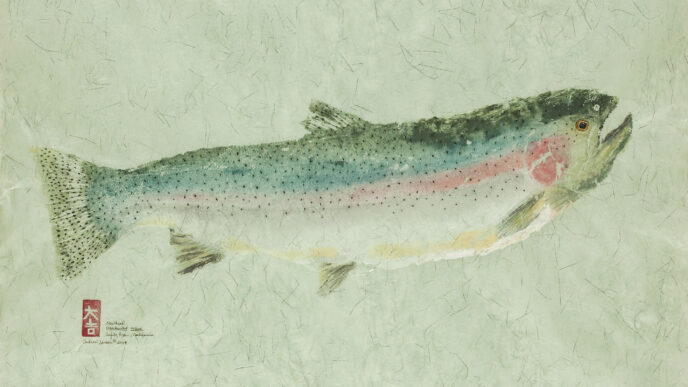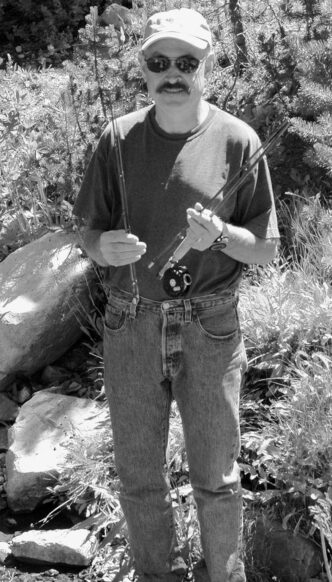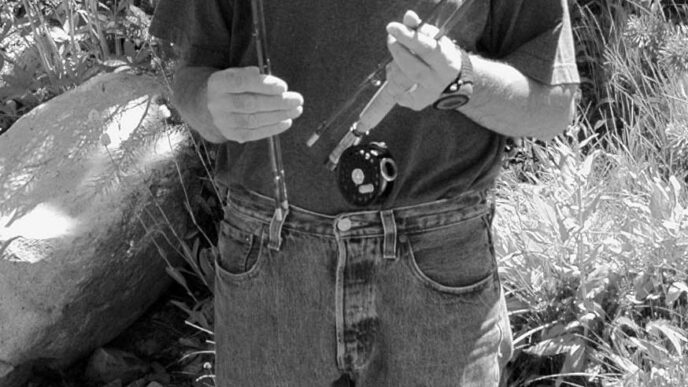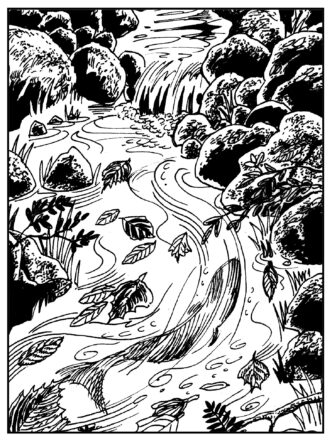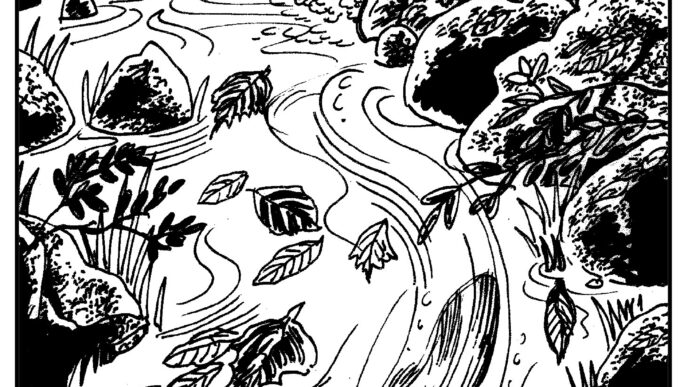Hal Janssen caught his first trout on a fly in 1950, when he was seven years old, on Alameda Creek, behind Ollie’s Beer Bar in Niles Canyon. The trout took a Glen L. Evans Royal Coachman wet fly that Hal had purchased at P. C. Hanson’s Hardware in Niles. Little did that 10-inch rainbow know that it participated in the start of a career that has included angling, outdoor, and automotive art hall of fame awards and 60 years of unbroken angling excellence.
Hal is an internationally recognized artist, lecturer, and video personality. He has held fly-caught world records, and his wall of Field & Stream medals would make General Patton blush. His marabou leech, Mylar, and epoxy fly patterns, along with numerous other original patterns he has developed, are preserved in fly showcases that grace museums and private collections here and abroad. His fly-line designs and fly-rod and reel innovations are well documented. His videos, Hal Janssen’s Fly-Fishing Secrets, were the first fly-fishing instructional videos ever produced. Through the years, Hal has published many flyfishing articles and photographs. His “living wood” fish carvings are unique. Hal fishes over 220 days a year and is generally acclaimed among fly-fishing aficionados as one of the finest and most accomplished fly fishermen who has ever lived.
This interview was conducted by Art Dollosso at the Golden Gate Angling and Casting Club in San Francisco and at Hal’s home in Forest Ranch, California.
Art: And what has the Grand Sachem and Tribe Elder been up to these days?
Hal: Primarily working on my stillwater fly-fishing book, woodcarvings, custom fly showcases, fly-fishing shows, fly-fishing seminars, teaching, and fishing.
Art: How about a brief rundown on the life and times of Hal Janssen?
Hal: It all started at Alameda Creek in Niles, California, where I grew up, fishing for anything that swims. I saw a Field & Stream magazine cover of a leaping rainbow trout with a fly in its mouth — it aroused my curiosity — when I was six years old. The local hardware store had folded cardboard displays of snelled trout flies that were beautiful. I could not keep my eyes off them. They aroused my interest, and I never really looked back. My father, Harold Janssen, was always around to take me fishing, and with his encouragement, I developed a love for fly fishing. If Dad wasn’t around, my Schwinn was — and off I went.
My parents had a cabin in the Santa Cruz Mountains, and I became a winter steelhead regular on the San Lorenzo River. After high school, I had a job as a fire lookout on Chalks Mountain and as a firefighter at the Sandy Point Fire Station, above Big Basin State Park. This provided me with the time to tie flies and experiment with new fly patterns on the nearby coastal lagoons.
Always looking for better ideas, one year I mentioned to my California Department of Forestry supervisor that it would be a good idea to paint large numbers on the roofs of the fire equipment so planes and helicopters could direct them from above. Two years later, most of the fire trucks had numbers painted on their roofs.
My first real full-time job was as a clothing salesman. After that, I sold insurance. But the real break in my life was when I worked at the Sports Chalet in Pleasant Hill, California, managing the store’s fly-fishing department. We were the only show in town and stocked only the best of the best equipment. It was while at the Sports Chalet that I came up with the idea to found the Diablo Valley Fly-Fishing Club, which is still going strong 40 years later. I then went on the road selling sporting goods. It was no coincidence that my sales routes always ended near a lake a river or stream. I usually fished, then slept in my Ford van. When I retired it, the odometer read 762,000 miles.
Another opportunity came when I took a job at Sunset Line and Twine Company in Petaluma, developing, selling, and testing fly lines. After working at Sunset, I started my own business, the Hal Janssen Company, distributing fly-fishing equipment to fly shops worldwide. I met my wife, Jane, shortly after starting the business, and both of us ran the business successfully for 30 years before retiring.
Art: It’s been said by folks such as John Merwin, Mike Mercer, Joseph Bates, Randall Kaufmann, and Dan Blanton that there might not be any better stillwater fisherman who has ever lived. How did you develop that level of skill?
Hal: A passion for fly-fishing and 220 days a year on the water for 40-plus years is a pretty good formula. Also setting up in my home 10 aquariums, each containing different types of aquatic organisms that trout eat, giving me the ability to study first-hand their habits and movements. From these observations, I could determine the appropriate materials to imitate their size, movements, and color. It also helped to have my good friend Gary Howells, a terrific bamboo rod builder and fly tyer, as my mentor. If you want to be a successful fly fisher, you need to acquire and absorb information from as many sources as possible.
Art: You still use fiberglass rods. Why?
Hal: This has to do with my leader systems. More often than not in still water, I am using leaders that are in excess of 20 to 25 feet long with 7X tippets. You need a flyrod material that will cast these long leaders and absorb the shock of the take without breaking the light tippet. In the 1960s, I developed a series of fiberglass rod blanks with the J. Kennedy Fisher Company, and to this day, they continue to meet my everyday requirements. I use a 3-weight rod and small, lightweight Hardy reel for just about everything except coastal steelhead and salmon. My passion is to fish difficult places for difficult fish with small flies. Fooling any trout is exciting. It’s the “take” that is exciting, not the size of the fish. Fly-fishing success is not measured in numbers, but in the knowledge gained from the challenges the angler accepts.
Art: Back in the 1960s, you landed 317 steelhead the same year that Bill Schaadt landed over 550. Do any of those steelhead stick out in your mind?
Hal: Could you really pick out the most beautiful Miss America? I don’t think so. Any steelhead, no matter its size, is a blackout experience. When the take occurs, you are frozen completely in that moment. It’s a screeching reel, an unpredictable, acrobatic fish, that make time stand still.
Art: The year you landed three 20-pound steelhead and a 50-pound chinook salmon on the Smith River: was that a bit of luck — just the right circumstances?
Hal: No, not really, it’s a matter of time on the water, more than anything else, observing with patience and experience. You have to understand that none of us had much money. Schaadt, Bertaina, Chatham, Nauheim — we were happy if we had money for gas to get to the river. We weren’t staying in fancy hotels — we slept in our vehicles near the river. At first light, we were on the water and left only when the sun went down and it was dark. We packed a lunch and never left the river. It was where we wanted to be. Schaadt said, “Never leave the river to warm yourself by a fire, because when you return to the water, you will get chilled, and your fishing is done for the day.” We all had a fire burning inside us — our friendship and our commitment to the grab kept us in the lineup, no matter what river we were on.
Art: Any commentary on that crew back then?
Hal: I always thought that Frank Bertaina was the smoothest fly caster I ever fished with. Bill Schaadt was the longest caster and the most consistent. I never saw him tangle or make a bad cast, ever. He was also the most knowledgeable and the best steelhead and salmon fisherman ever.
Art: Ever fish with anyone famous?
Hal: Joe DiMaggio at Bing Crosby’s Rising River Ranch, Ted Williams on the Miramachi [There is a fly display of Atlantic salmon patterns on Hal’s wall, tied and signed by Williams with the note “Hal, thanks for teaching how to tie steelhead flies, Ted Williams”]. I also fished with Ernie Schwiebert, Joe and Mary Brooks, Ted Trueblood, John Goddard from England, as well as other notables.
Art: How about your most memorable fish?
Hal: Easy — my first grayling, a three-pound fish, at the Widow’s Pool in Montana and the four hours of rejection before I was able to get it to take my fly. It was as beautiful as the moment, the purple, cherry, gold, pale blue, and bright green colors would rival the beauty of any fish I’ve ever caught — just unbelievable!
Art: Favorite California places to fish?
Hal: Any place that is difficult, like the technical fly presentations needed on Hat Creek at the old Carbon Bridge area. The Gualala comes to mind for steelhead. Eagle Lake for still water.
Art: One fly, just one, that seems to be consistently productive?
Hal: The Janssen Emerging Callibaetis Nymph
Art: Got any spares?
Hal: (Silence)
Art: Unusual catches?
Hal: A fly-caught six-foot sturgeon up on Salmon Creek. Once, an 18-pound Canadian honker swam up to my floating Hex fly and grabbed it. After an ensuing battle, I removed the fly from the goose’s beak and him sent on his way in good condition. I caught a grebe in Monterrey Bay while fly fishing for rock cod with Myron Gregory. And one more thing, in the San Lorenzo River I hooked a dead body. That still gives me chills.
Art: In looking at the draft of your stillwater angling book, I’m thinking that it looks to be about the size of an old San Francisco phone book. Can you talk about that book a bit?
Hal: Sure. Jane and I are nearly finished with Stillwater Fly-Fishing Secrets. My original 42 patterns, hand painted, with instructional tying steps are in there, but more than that, there’s information on how and when to use them, using the necessary retrieve to emulate the correct movement, and my leader and line systems.
If you don’t believe that fly-line color matters, then don’t read this book — because it does matter. I’ve also drawn every rise form, and you’ll be able to identify what insect the trout is feeding on and which imitation to use.
I have a section on rods and reels and on the weather — wind, in particular — because it has a great influence on how a nymph does or does not make it to its destination. I discuss the food chain — vegetation, algae, and water content — because each has direct bearing on a fish and each is a link to each other.
Art: Tell me in few words what you’ll remember most about your fishing experiences.
Hal: You know, I can’t help but think of my conversations with Bill Schaadt at a Santa Rosa Hospital. He was dying of cancer. He was alert, but had a difficult time speaking. I asked Bill your same question, “What was the most important thing to you about fly fishing.” His eyes opened wide and he looked at me. He said, “The grab.” I could not have said it better. I will never forget how definitive he was with his statement.
Art: Here we are at the end of the interview, with our Silly Tree Question. If you were a tree, which tree would you be?
Hal: Ironwood. It’s tough.
…………………………………………………………
Hal can be contacted at perfectcast@att.net.



